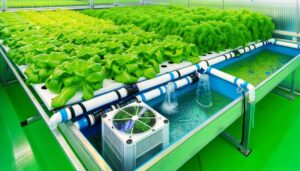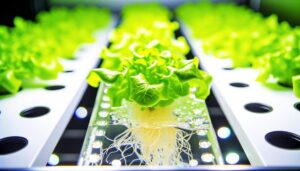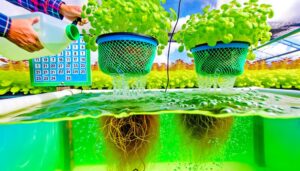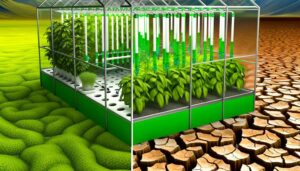Top Feed Hydroponics Water Schedule
Creating a precise top feed hydroponics water schedule is essential for plant health and resource efficiency. Utilize drip irrigation to deliver nutrient-rich water directly to plant bases, guaranteeing consistent moisture and nutrition.
Schedule short, frequent waterings—typically 15-30 minutes—aligned with plant circadian rhythms. Adjust the volume to 10-20% of the growing medium daily.
Tailor the schedule to the plant's growth stages, increasing water during the vegetative phase and balancing it during flowering. Monitoring pH, electrical conductivity (EC), and nutrient levels guarantees ideal uptake and growth.
Master these elements, and you'll see substantial improvements in yield and plant health.
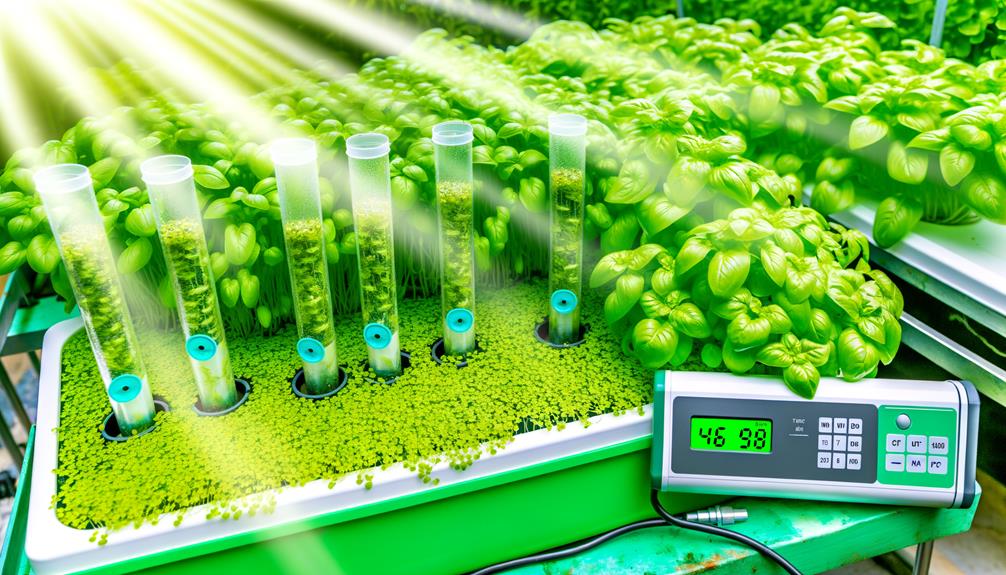
Key Takeaways
- Adjust watering frequency and volume based on plant growth stages to ensure efficient nutrient delivery.
- Maintain daily watering volumes at 10-20% of the growing medium volume to prevent waterlogging.
- Use short, frequent watering intervals of 15-30 minutes to optimize root oxygenation and nutrient uptake.
- Monitor and adjust nutrient solution pH (5.5-6.5) and EC (1.0-2.5 mS/cm) for ideal plant health.
Understanding Top Feed Hydroponics
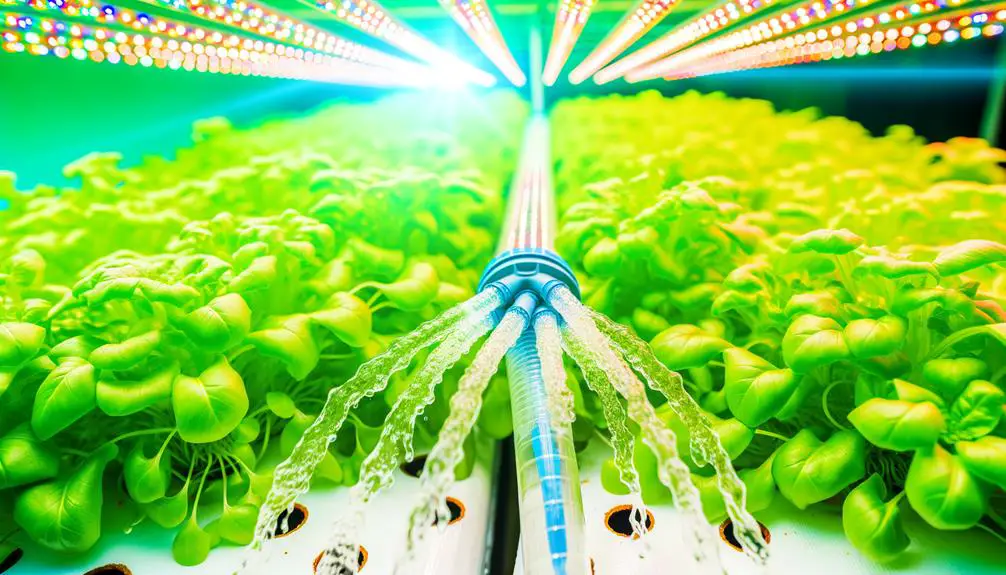
Top feed hydroponics, frequently referred to as drip irrigation, involves delivering nutrient-rich water directly to the base of each plant through a network of tubes and emitters.
This method guarantees precise control over the nutrient delivery, optimizing plant growth and health.
The system consists of a reservoir, pump, tubing, and emitters, which work in unison to provide consistent hydration and nutrients.
Drip emitters can be adjusted to control the flow rate, accommodating the specific needs of various plant species and growth stages.
This high level of customization and efficiency minimizes water usage and nutrient waste, making top feed hydroponics an ideal choice for sustainable and scalable agricultural practices focused on maximizing yield and resource efficiency.
Importance of Water Scheduling
Precise water scheduling in top feed hydroponics is essential for maintaining ideal plant health and maximizing growth efficiency.
Ensuring a consistent and accurate delivery of water and nutrients directly influences the root zone environment, which is critical for peak nutrient uptake.
By meticulously timing water applications, growers can prevent waterlogging and root rot, enhance oxygen availability, and maintain stable pH levels.
This precision-driven approach minimizes wastage of resources and supports sustainable farming practices.
Additionally, tailored water schedules accommodate the specific growth stages of plants, promoting robust development and higher yields.
Implementing advanced automation systems can further refine scheduling accuracy, enabling real-time adjustments based on environmental parameters, thereby fostering an innovative and responsive hydroponic ecosystem.
Key Factors in Water Timing

In determining ideal water timing for top feed hydroponics, several critical factors must be considered to guarantee efficient nutrient delivery and plant health.
Key elements include plant growth stage, substrate type, and environmental conditions. Young seedlings require more frequent, shorter watering intervals, while mature plants benefit from less frequent, longer sessions.
The substrate's water retention capacity greatly impacts timing; highly absorbent media need less frequent watering.
Environmental conditions such as temperature, humidity, and light intensity also dictate water needs. Higher temperatures and light levels increase transpiration rates, necessitating more frequent irrigation.
Precision in timing guarantees that plants receive prime hydration without risk of root rot or nutrient leaching, ultimately promoting robust growth and maximizing yield potential.
Setting Up Your System
Establishing an efficient top feed hydroponics system requires meticulous planning and precise assembly to guarantee excellent plant growth and nutrient delivery. Begin by selecting high-quality reservoirs, pumps, and tubing to facilitate robust water circulation. Accurately measure nutrient solutions to maintain prime pH and electrical conductivity (EC) levels. Implement timers for automated feeding cycles, ensuring consistent nutrient delivery.
Below is a critical component checklist:
| Component | Specification | Function |
|---|---|---|
| Reservoir | 20-50 gallons | Stores nutrient solution |
| Pump | 400-800 GPH | Circulates water through the system |
| Tubing | FDA-approved, 1/2 inch | Transports nutrient solution to plant roots |
Daily Watering Guidelines
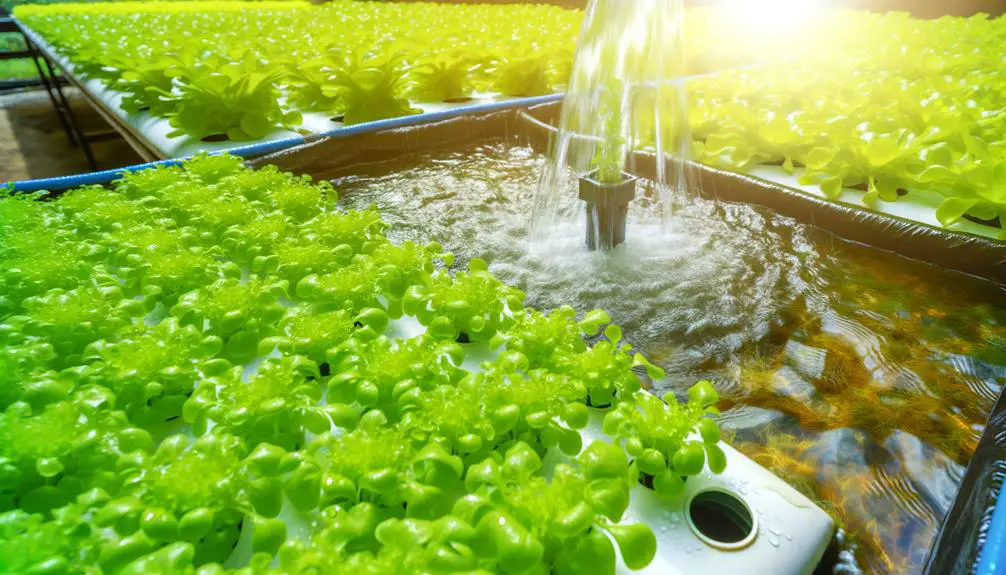
Effective daily watering in a top feed hydroponics system hinges on ideal watering times, precise water volume recommendations, and adjustments based on plant growth stages.
Timely watering guarantees nutrient availability and root oxygenation, while correct volumes prevent over-saturation.
Monitoring and adjusting these parameters as plants develop are essential for maintaining system efficiency and plant health.
Optimal Watering Times
Determining the ideal watering times for a top feed hydroponics system is essential for ensuring plant health and maximizing growth efficiency.
For best results, watering should coincide with the plant's circadian rhythms. Typically, this involves initiating watering cycles shortly after the lights turn on, allowing plants to absorb nutrients during their active growth phase.
Watering sessions should be evenly spaced throughout the photoperiod, ensuring consistent nutrient delivery and preventing root desiccation.
Short, frequent watering intervals—ranging from 15 to 30 minutes, depending on plant size and growth stage—are recommended. This approach minimizes the risk of over-saturation while maintaining best oxygen levels in the root zone.
Precision in timing directly correlates with enhanced nutrient uptake and robust plant development.
Water Volume Recommendations
Accurate water volume recommendations are critical for maintaining ideal nutrient delivery and preventing plant stress in a top feed hydroponics system.
Precise daily watering guidelines generally suggest providing 10-20% of the total volume of the growing medium in water per day. This range guarantees peak root zone hydration without oversaturation, which can lead to root rot or nutrient imbalances.
Advanced monitoring tools, such as moisture sensors and automated control systems, can fine-tune water delivery, enhancing consistency and efficiency.
Additionally, water quality parameters—pH, electrical conductivity (EC), and dissolved oxygen levels—should be regularly monitored and adjusted to guarantee nutrient uptake.
Employing data-driven strategies will help maximize plant growth and yield in a top feed hydroponics setup.
Adjusting for Plant Growth
Adapting the daily watering schedule to the various stages of plant growth is vital for optimizing health and yield in a top feed hydroponics system. Precise adjustments guarantee appropriate nutrient delivery and root oxygenation. During the seedling stage, minimal watering suffices to prevent root rot and promote initial growth. As plants shift to the vegetative phase, increased watering supports rapid foliage development. Finally, in the flowering stage, a balanced schedule maintains nutrient uptake and supports fruiting.
| Growth Stage | Frequency | Duration |
|---|---|---|
| Seedling | 1-2 times/day | 5-10 minutes/feed |
| Vegetative | 2-3 times/day | 10-15 minutes/feed |
| Flowering | 3-4 times/day | 15-20 minutes/feed |
Understanding these variations is significant for hydroponic success.
Adjusting for Plant Growth
As plants progress through different growth stages, it is imperative to adjust the hydroponic water schedule to meet their evolving nutritional and hydration needs.
Seedlings require a higher frequency of watering with lower nutrient concentrations to establish root systems.
During the vegetative stage, increase nutrient concentration and extend watering intervals to encourage robust foliage development.
In the flowering stage, enhance nutrient solutions to support bud formation while ensuring balanced hydration.
Precision in adjusting water schedules is essential to prevent nutrient lockout and water stress.
Implementing an adaptive water schedule fosters ideal plant health and maximizes yield potential, showcasing the innovation and precision of hydroponic systems.
Monitoring and Troubleshooting
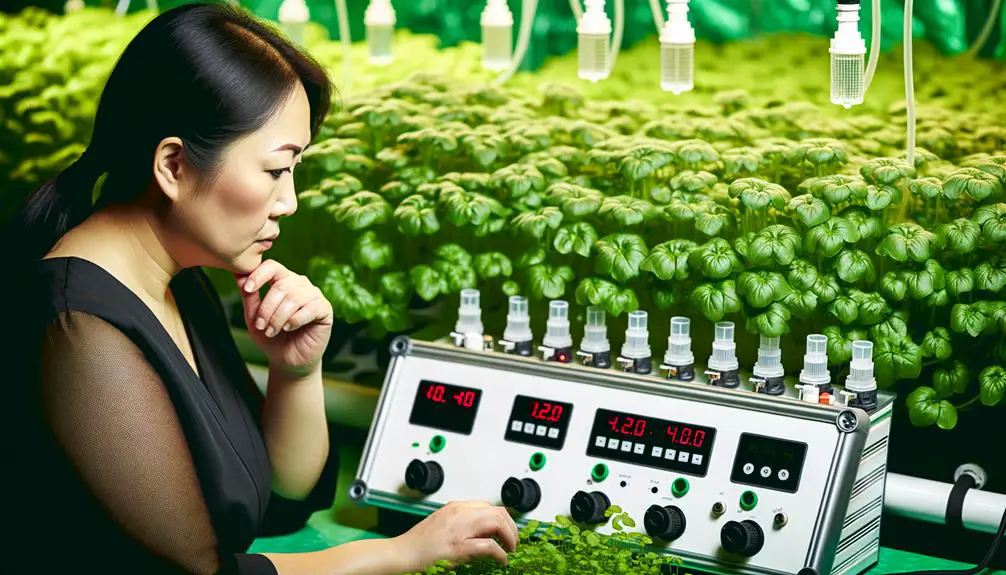
Effective monitoring and troubleshooting of a top feed hydroponics system require identifying common issues such as nutrient imbalances and root rot.
Tracking system performance through regular checks on pH levels, water temperature, and flow rates is crucial.
Adjusting nutrient levels based on plant growth stages and observed deficiencies guarantees ideal plant health and productivity.
Identifying Common Issues
Monitoring and troubleshooting common issues in top feed hydroponics systems require a keen understanding of potential problems such as nutrient imbalances, water flow inconsistencies, and root health complications.
Nutrient imbalances can manifest as chlorosis or necrosis in plant leaves, often due to incorrect nutrient solution concentrations.
Water flow inconsistencies, resulting from clogged emitters or pump malfunctions, can lead to uneven distribution of nutrients and water, adversely affecting plant growth.
Root health complications, identified by root browning or sliminess, often indicate issues like root rot, typically caused by poor oxygenation or pathogen presence.
Regularly inspecting these elements and maintaining ideal conditions guarantees robust plant development and maximizes the efficiency of top feed hydroponic systems.
Tracking System Performance
Ensuring the ideal performance of a top feed hydroponics system necessitates rigorous tracking of various parameters to promptly identify and address any operational discrepancies.
Critical metrics include water pH, electrical conductivity (EC), temperature, and flow rate.
Automated sensors and data logging tools are instrumental in providing real-time feedback, enabling immediate corrective actions when deviations occur.
Additionally, periodic manual inspections complement automated monitoring by verifying system integrity and identifying subtle issues that sensors might miss.
Utilizing advanced software platforms for data analysis can reveal trends and preempt potential failures.
Adjusting Nutrient Levels
Accurate nutrient level adjustments are vital in maintaining the ideal growth environment within a top feed hydroponics system.
Regular monitoring of pH and electrical conductivity (EC) is critical to guarantee nutrient availability and uptake. Utilize calibrated digital meters for precise measurements.
Adjust pH to the ideal range of 5.5-6.5 using pH up or down solutions. For EC, target ranges vary by plant species but generally fall between 1.0-2.5 mS/cm.
Deviations in these metrics can indicate nutrient imbalances or system inefficiencies. Implement corrective measures promptly, such as adjusting nutrient concentrations or flushing the system to prevent deficiencies and toxicities.
Advanced Tips for Optimization
Optimizing a top feed hydroponics water schedule requires a deep understanding of plant nutrient uptake, water quality parameters, and environmental conditions. Precision in these areas guarantees maximum growth and yield. Here are three advanced tips for enhancement:
- Monitor Electrical Conductivity (EC) and pH: Regularly check EC and pH levels to maintain an ideal nutrient solution balance. Deviations can lead to nutrient lockout or toxicity, impacting plant health.
- Utilize Automated Systems: Integrate automated sensors and controllers for real-time adjustments. This minimizes human error and guarantees consistent environmental conditions, fostering robust plant growth.
- Tailor Watering Intervals: Adjust watering frequency based on plant growth stages and environmental factors. Implementing variable schedules can prevent root zone issues like overwatering or nutrient depletion.
These strategies are pivotal for achieving superior hydroponic performance.
Conclusion
In summary, the implementation of an effective water schedule in top feed hydroponics is paramount for ideal plant growth. This ensures that plants receive adequate hydration and nutrients at optimal intervals, preventing both over- and under-watering. Proper management of hydroponics water supply needs also helps maintain stable oxygen levels in the root zone, promoting healthy development. By closely monitoring and adjusting the schedule, growers can maximize efficiency and achieve consistent, high-quality yields.
Factors such as system setup, daily watering guidelines, and adjustments for plant development must be meticulously managed.
Continuous monitoring and troubleshooting guarantee system efficiency, while advanced enhancement techniques further boost yield.
By adhering to these principles, cultivators can achieve superior results, making their hydroponic systems as efficient as a well-oiled machine, akin to the precision of a Swiss watch.


